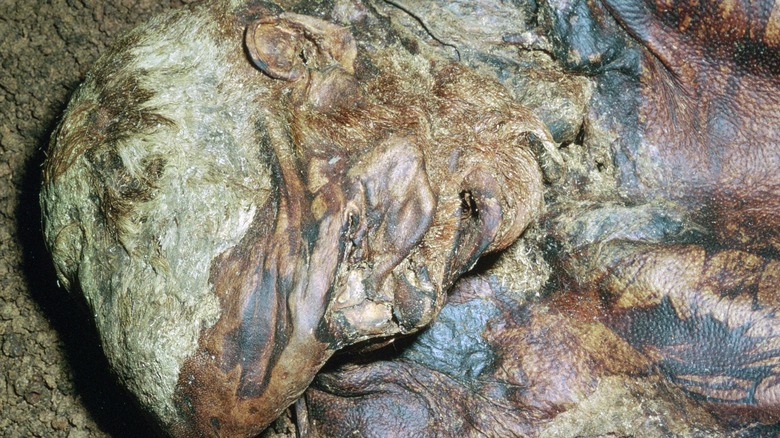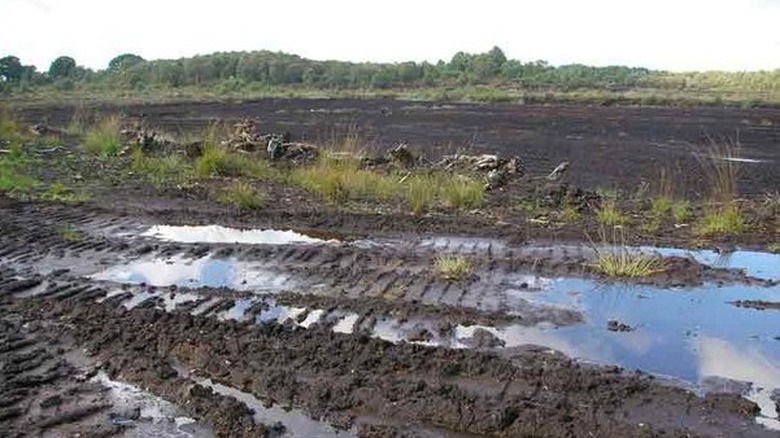How A Bog Body Discovery Led To A Murder Confession
This article contains mentions of violence and child sex abuse.
On May 13, 1983, Stephen Dooley and Andy Mould were harvesting peat moss at the Lindow Moss bog in Cheshire County, England, when they made a shocking discovery. As an article published by Science History in 2019 summarized, the men were watching a conveyor belt carrying out dug-up peat when they spotted an unusual object resembling a ball. They subsequently removed the mud-covered object and took it to their supervisor. It was only after they washed away the dirt and debris that they discovered, to their horror, that it was a human skull.
Per Science History, the skull was largely intact, save for a missing lower jaw bone. It was also astonishingly well-preserved: The skin, hair, and one of the eyeballs had avoided decay, and its state initially led everyone to believe it had only been in the bog for a short period of time. Preliminary examinations of the skull conducted by forensic analysts first concluded it belonged to a woman who was between the ages of 30 and 50 when she died. But who was she?
According to Science History, local authorities immediately suspected the skull belonged to a local portrait artist named Malika Maria de Fernandez, who had been reported missing in the early 1960s. At the time, authorities suspected Fernandez's husband, Peter Reyn-Bardt, was responsible for her disappearance. They also suspected that he killed his wife and had possibly dumped her body in Lindow Moss, as it was only 900 feet from the property he owned.
A skull found in Lindow Moss was initially linked to a murder
Although Peter Reyn-Bardt and Malika Maria de Fernandez were married in 1959, they did not live traditionally as husband and wife. Per Science History, Reyn-Bardt was rumored at the time to be gay. Along with this, de Fernandez enjoyed traveling and was rarely home. Within months of their marriage, de Fernandez left for another trip and Reyn-Bardt stayed in Cheshire County with another man who was purportedly his lover. According to a later account given by Reyn-Bart, de Fernandez returned to England in order to purportedly ask Reyn-Bardt for money (via Science History). When he refused, Reyn-Bardt claimed she threatened to turn him into the British authorities over his homosexuality, which at that time was criminalized in the U.K. Shortly thereafter, she vanished and was never seen again.
In the years between his wife's disappearance and the discovery of the skull in Lindow Moss, Reyn-Bardt was arrested and convicted of committing sex abuse crimes against several children, per Science History. He had recently been released from prison when authorities brought him in for questioning about the skull. Assuming authorities had enough evidence to make an arrest, Reyn-Bardt immediately confessed to killing de Fernandez and scattering her remains at Lindow Moss. In his confession, Reyn-Bardt stated he became enraged when de Fernandez supposedly threatened to expose his sexuality. In response, he grabbed her by the shoulders and shook her. According to Science History, Reyn-Bardt said he did not intend to kill his wife but was "terrified and could not think clearly."
The tell-tale skull wasn't what everyone thought it was
With a confession, and what they believed to be Malika Maria de Frenandez's skull, authorities believed they had enough evidence for prosecutors to secure a murder conviction against Peter Reyn-Bardt, per Science History. But soon after Reyn-Bardt confessed to the crime, his trial was complicated by an unexpected twist. As Science History summarized, authorities conducted an extensive search of Lindow Moss after Reyn-Bardt's arrest and were unable to find the rest of de Fernandez's remains –- which, as they reasoned, should have been as well-preserved as the discovered skull. After failing to detect anything at the assumed crime scene, Detective Inspector George Abbott, who was in charge of the investigation, eventually decided to send the skull to Oxford University for a more thorough examination.
The ensuing results were both unexpected and remarkable. The skull was again confirmed to be that of a woman between the ages of 30 and 50 — but it could not have belonged to de Fernandez. The reason? As Science History noted, experts determined it to be approximately 1700 years old. Unsurprisingly, this revelation prompted Reyn-Bardt to recant his confession — the skull clearly did not belong to his wife. He also requested that his murder charge be reduced to the lesser charge of manslaughter. However, in the end, both of his requests were denied.
Peter Reyn-Bardt was ultimately convicted of murder
Although an Oxford University professor who worked in the archaeology department testified at Peter Reyn-Bardt's trial to confirm the actual age of the skull, the jury was not swayed. As Science History noted, Reyn-Bardt was convicted of murder for the death of Malika Maria de Fernandez and subsequently sentenced to life in prison. Unfortunately, at the time of this writing, no trace of de Fernandez's body has ever been found.
But the woman's skull found in Lindow Moss ended up being the first of several ancient, well-preserved, and largely intact remains discovered in the Lindow Moss bog. As The Atlantic reported in 2016, there's a scientific reason for this. Bogs like the one at Lindow Moss provide a unique environment for this type of preservation, as their native peat is able to prevent the decay of soft organic tissue despite the disintegration of harder material like bone. Although so-called "bog bodies" are usually misshapen due to bone decomposition, soft tissue like skin and hair remain extraordinarily intact. Other organic materials, including fur, wood, and certain textiles, are also able to be preserved. Unfortunately, the acidic nature of the bogs destroys all DNA.
As The Atlantic pointed out, bogs contain very little oxygen, an element necessary for the growth of bacteria that aid the decomposition process. Even though bogs do contain some bacteria, their metabolic infrastructure is inhibited by polysaccharides, a type of carbohydrate released by sphagnum plants (or, in other words, peat moss) found in those ecosystems.
Several bog bodies were later found at Lindow Moss
Although they are thousands of years old, bog bodies often have enough preserved tissue to provide scientists with a wealth of information about who they were before they died. Per The Atlantic, scientists who are able to examine the soft preserved tissue of remains like those found at Lindow Moss can determine things like their cause of death, their medical history, and even their social status. In at least one case, they were able to determine the last meal consumed by a man found in a bog.
When it came to the remains of the woman found in Lindow Moss in 1983, things got a bit tricker. Because the sample they were working with was limited to her skull, scientists were unable to conclusively prove how she actually died. However, the remains of a man found one year later in the same bog were far more complete and provided some disturbing details about his life and death. According to BBC, the body, later given the name "Lindow Man," died in his 20s. While they found he was generally healthy, they also discovered evidence that he carried parasitic intestinal worms in his digestive system, and that his last meal was unleavened bread. Per the BBC, Lindow Man's fingernails, which were manicured, led experts to theorize that he most likely did not perform manual labor. They also noted his beard and mustache, both intact, were well-groomed.
Scientists believe the bog bodies in Lindow Moss were religious sacrifices
So how did the Lindow Man die? Speaking with the BBC in 2014, Anthony Jones, a professor at the University of Manchester, hypothesized the Lindow Man "was killed by blows to the head, garrotting, swallowing mistletoe, and then drowning in the waters of the peat bog." Although it is unclear why the Lindow Man died in such an unusual and violent way, it's suspected that he was killed as part of a religious sacrifice –- either with his permission or against his will. Jones also added that the location of Lindow Moss was key, putting forward the idea that it "was probably a site of religious significance where sacrifices were made." However, it's difficult to say this with complete certainty, as it's unknown what religion the people in that era and area practiced.
Although little is known about the woman found at Lindow Moss in 1983, it is believed that she also died as part of a religious sacrifice, per the BBC. In an interview with the media outlet, archaeologist Rick Turner said all of the ancient remains recovered from Lindow Moss "are best understood as religious human sacrifices made around the time the Romans" were in control of that particular region of England.





